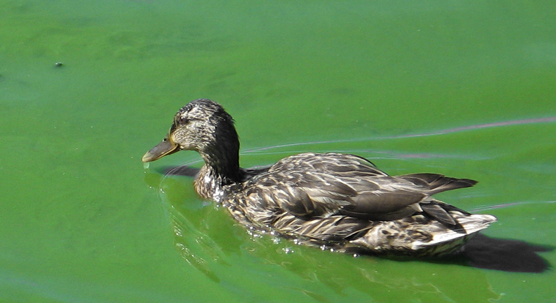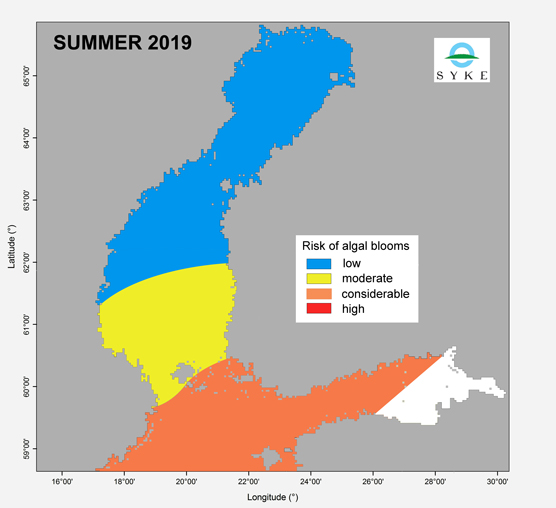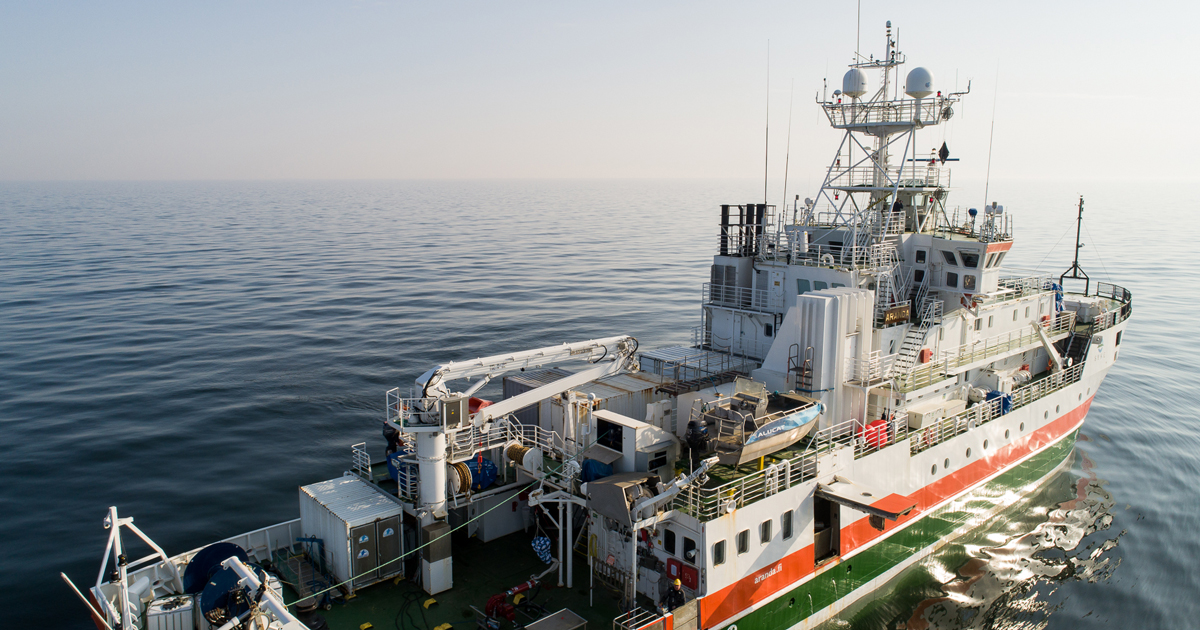Press release 2019-06-06 at 9:00

Blue-green algae near the shore. © Photo: SYKEkuva
Note: This press release has been updated on 6.6.2019 at 17:46. The original text claimed that the risk is moderate in the Finnish Archipelago Sea, though the risk is substantial also in that sea area. Areas marked in the map are correct.
The risk of significant and widespread blue-green algae blooms in Finnish sea areas matches that of previous years, since the nutrient situation has remained largely the same. This summer brings with it a substantial risk of blue-green algae formations in the Gulf of Finland, the northern part of the Baltic Proper and most of the Finnish Archipelago Sea. The risk is moderate in the south east Bothnian Sea. In other parts of the Bothnian Sea and the Bay of Bothnia, the risk is low. The weather conditions during the summer will determine whether or not the risk is realised.

Risk of algal blooms 2019. No winter nutrient data is available for the white area, which is why it has been excluded from the assessment. © SYKE
Weather during the summer season will determine the prevalence of algal blooms
The risk assessment on blue-green algae blooms is based on nitrogen and phosphorus levels during the past winter. SYKE and the Swedish Meteorological and Hydrological Institute (SMHI) have measured wintertime nutrient levels extensively through expeditions by the research vessel Aranda. Nutrient data for the Bay of Bothnia were also received from the University of Umeå. SYKE and the Finnish Meteorological Institute assess the risk of algal blooms by using the Baltic Sea ecosystem model. In addition to the winter nutrient amounts, the assessment accounts for the development of nutrient concentrations in the spring of 2019. Aranda’s research expeditions and the Alg@line monitoring efforts conducted by trade vessels provided the data for this purpose.
The nutrient situation in the winter season provides a regional overview of the availability of nutrients in the coming summer. Ultimately, however, the algae situation will be determined by the weather conditions. Blue-green algae thrive in warm water and also require plenty of light to grow. The algae grow slowly, which is why conditions must remain favourable for at least a couple of weeks for substantial blooms to form.
“This risk forecast issued at the beginning of June quite accurately indicates potential blooming areas of green-blue algae, but it is advisable to keep abreast of the actual situation based on weekly bulletins and visual observations,” says Group Leader Harri Kuosa of the Finnish Environment Institute.
The previous summers are a good example of this. Last summer, the risk of blue-green algae blooms was estimated to be lower than in 2017, but reality took a different turn. The summer of 2017 was exceptionally cold and cloudy, and virtually no blooms were observed. Last summer’s stagnant heat resulted in one of the most severe green-blue algae situations to plague our marine areas in recent years, despite the nutrient situation in winter implying that the risk level would be no higher than average.
The blue-green algae blooms in Finnish sea areas usually reach their peak in late July and early August. In some locations, blooms may occur late into the autumn season, but they are usually not as massive as during the summer.
Changes in the blue-green algae situation may be rapid
The movement of algae masses that have formed in open sea areas to coastal areas depends on the prevailing wind and current conditions. In our southern sea areas, for example, surface blooms of blue-green algae may travel to the archipelago and coastal areas, especially when southern winds are prevalent.
Strong winds mix blue-algae blooms into the surface water, making them harder to detect. During calm periods, in turn, blue-green algae rise back to the surface quickly.

The research vessel Aranda has been collecting nutrient data after its refurbishment during the winter 2018–2019. © Photo: Ilkka Lastumäki
The prevalence of green-blue algae can vary significantly, even within small areas. In coastal and archipelago areas, regional current conditions and local sources of nutrients may result in localised blue-green algae blooms, especially during an extended period of calm and warm conditions. In addition, wind may accumulate algae in coastal waters and on shores.
Blue-green algae may form different types of toxins and agents that irritate the skin. Significant blue-green algae blooms should always be treated with caution.
Algae communication begins
Finnish Environment Institute (SYKE) will issue weekly algal reviews on the general blue-green algae situation until the end of August. First weekly algal review will be published today (6th of June 2019) at 13:00.
More information
Algae bloom risk analysis in Finnish sea areas:
Group Leader Harri Kuosa, Finnish Environment Institute SYKE, firstname.lastname@ymparisto.fi, tel. +358 (0)295 251 106
Communication Specialist Eija Järvinen, Finnish Environment Institute SYKE, firstname.lastname@ymparisto.fi, +358 (0)295 251 242